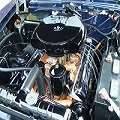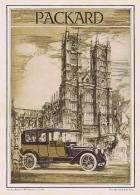|
Re: Preservation of newly cut brake drums
|
||||
|---|---|---|---|---|
|
Home away from home
|
Fred - One way would be to coat the surfaces of the drums with grease and then place them in plastic bags.
If you are referring to the rear axle bearings being greased and seated; then, I would place a plastic bag over the end of the axle and housing and tape carefully to keep moisture out. If you are referring to the front bearings; then, I would remove them from the drums and place in a plastic bag and secure them in there. Others here may have better ideas. (o{}o)
Posted on: 2014/7/17 16:11
|
|||
|
We move toward
And make happen What occupies our mind... (W. Scherer) |
||||
|
||||
|
Re: Preservation of newly cut brake drums
|
||||
|---|---|---|---|---|
|
Home away from home
|
JW
Thanks for the reply. They are the front drums. They were blasted, powder coated, cut to size, new cups & cones installed. Now I need to check out the seals then store them until I get ready to put it all back together. Fred D
Posted on: 2014/7/19 20:19
|
|||
|
||||
|
Re: Preservation of newly cut brake drums
|
||||
|---|---|---|---|---|
|
Home away from home
|
Dampen a rag with WD40 and rub it over the surfaces. That will hold it for a surprisingly long time and can be cleaned off with a good rub of cheap window cleaner before assembly.
Posted on: 2014/7/20 6:28
|
|||
|
||||
|
Re: Preservation of newly cut brake drums
|
||||
|---|---|---|---|---|
|
Forum Ambassador

|
That is EXACTLY what WD40 is designed for. Great suggestion.
Posted on: 2014/7/20 9:29
|
|||
|
||||
|
Re: Preservation of newly cut brake drums
|
||||
|---|---|---|---|---|
|
Home away from home

|
Just my two cents, when it come to drums and rotors, I perform a Cryogenic hardening and then Center Grind the Rotors and Drums to spec. In doing this process, you will NEVER need to turn drums again, and they don't wear. I also use this process on engine, and transmission components. We use this process a lot for the Racing industry and Clutch and flywheel surfaces are a huge market as well.
Cryogenic Processing is a one time, permanent and irreversible treatment that affects the entire object, not just the surface. Cryogenics is a form of heat treat. The material being treated is exposed to extremely cold temperatures in a controlled atmosphere. As the material drops in temperature the molecular movement starts to slow down and the individual molecules move closer together. When the temperature is maintained at below -300? F the molecules virtually stop moving and become very compact. Upon thawing at a controlled rate they begin to spread out evenly, creating a consistent molecular pattern. When the material becomes room temperature again all the molecules are now distributed equally and aligned in an extremely consistent grain pattern. The new consistent grain structure distributes the flow of energy evenly throughout the entire object, eliminating stress points. This elimination of stress points creates a consistent and evenly distributed microstructure. The treated material has a new grain pattern with no weak points and is stronger and more durable than ever before. In scientific terms the process is a transformation of the retained austenite structure into a martensite atom structure. The soft retained austenite atom structure is changed by using the correct cycle of temperature changes into its harder form, which is a martensite atom structure. This is the actual strengthening agent. A good comparison can be made between the Cryogenic Process and the quenching of melted metal ore. Quenching is the rapid cooling of metal using water or oil. The Cryogenic Process can be thought of in the same fashion, except that Cryogenics takes the quenching process to -300 degrees F and is a dry process.
Posted on: 2014/7/20 9:57
|
|||
|
[url=https://packardinfo.com/xoops/html/modules/
|
||||
|
||||
|
Re: Preservation of newly cut brake drums
|
||||
|---|---|---|---|---|
|
Home away from home

|
Dear 40-120:
Don't put anything on them especially oil or grease. The cast iron will absorb the oil and the metal will glaze and possibly cause chatter. You can put them in plastic bags with desiccant beads or with anti-corrosion paper. WD-40 stands for Water Displacer number 40 which is the 40th compound developed by the engineers for that purpose. You can get desiccant packs through Wal-Mart for under $10, and lots of other places as well. It also helps to keep them in a warm dry place such as an upstairs closet.
Posted on: 2014/7/20 13:56
|
|||
|
||||
|
Re: Preservation of newly cut brake drums
|
||||
|---|---|---|---|---|
|
Home away from home
|
Thank you everybody for the informative solutions.
I think I am going to go the route with the desiccant and plastic bags. thanks again Fred D
Posted on: 2014/7/20 19:00
|
|||
|
||||








